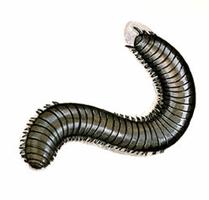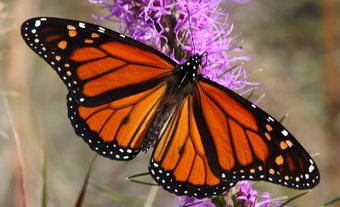
Millipede (class Diplopoda), terrestrial, usually elongate arthropod with a small head and short antennae. Typically, the body is very hard and subcylindrical, but often with platelike expansions making the animal appear flattened.
The body comprises 11-100 or more similar segments which, except for the first 3-4, consist of fused pairs of true segments. The first and last true segments and the anal plate lack appendages. The second, third and, usually, fourth segments each bear one pair of legs; other segments, 2 pairs. Some appendages in functional adults are modified for reproduction.
Despite the name millipede ("1000-footed"), the number of legs is less than 400, and generally less than 200. Newly hatched millipedes have 3-4 pairs of legs; the number increases following successive molts.
Range
About 10 000 species are known worldwide, mostly from tropical regions. More than 60 species are known to occur in Canada. About 10% of these, particularly in the East, have been introduced from Europe. In Western Canada, fossils of marine, millipedelike arthropods, not directly ancestral to any living group, are known from the mid-Cambrian (530 million years ago).
Size
Tropical millipedes sometimes grow to 30 cm; Canada's largest species barely attain 8 cm; many common species are less than 1 cm long and 1 mm in diameter.
Habitat
Cylindrical millipedes usually burrow in soil; "flat-backs" occupy matted, rotting vegetation. A few spend periods on the surface, mainly at night. Millipedes are important in soil formation in some deciduous and tropical forests. Virtually all feed on decayed matter or fresh vegetation.
Interaction with Humans
One or 2 species have been considered to be crop pests but, usually, damage done follows other injury to plants. An alarmed millipede typically coils itself into a spiral; some flat-backs are incapable of coiling; very short, exotic species may roll into a ball. Millipedes often protect themselves by noxious body secretions. Those of large, tropical species may cause skin and eye inflammation. Canadian species are harmless.

 Share on Facebook
Share on Facebook Share on X
Share on X Share by Email
Share by Email Share on Google Classroom
Share on Google Classroom


